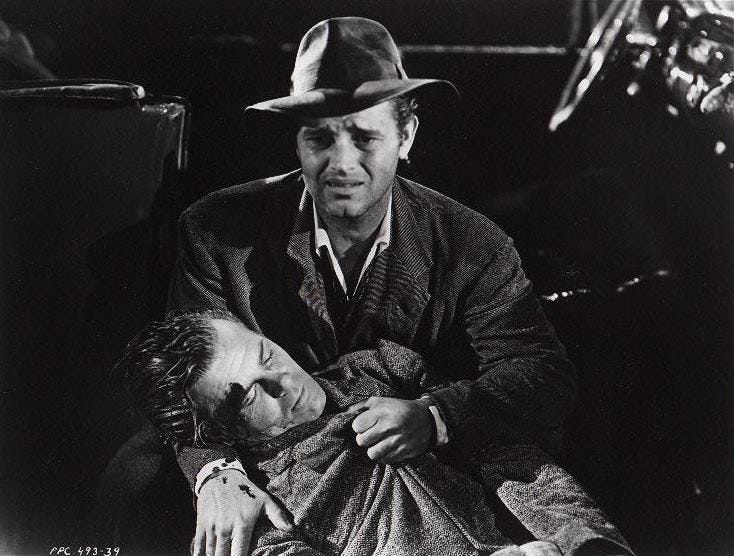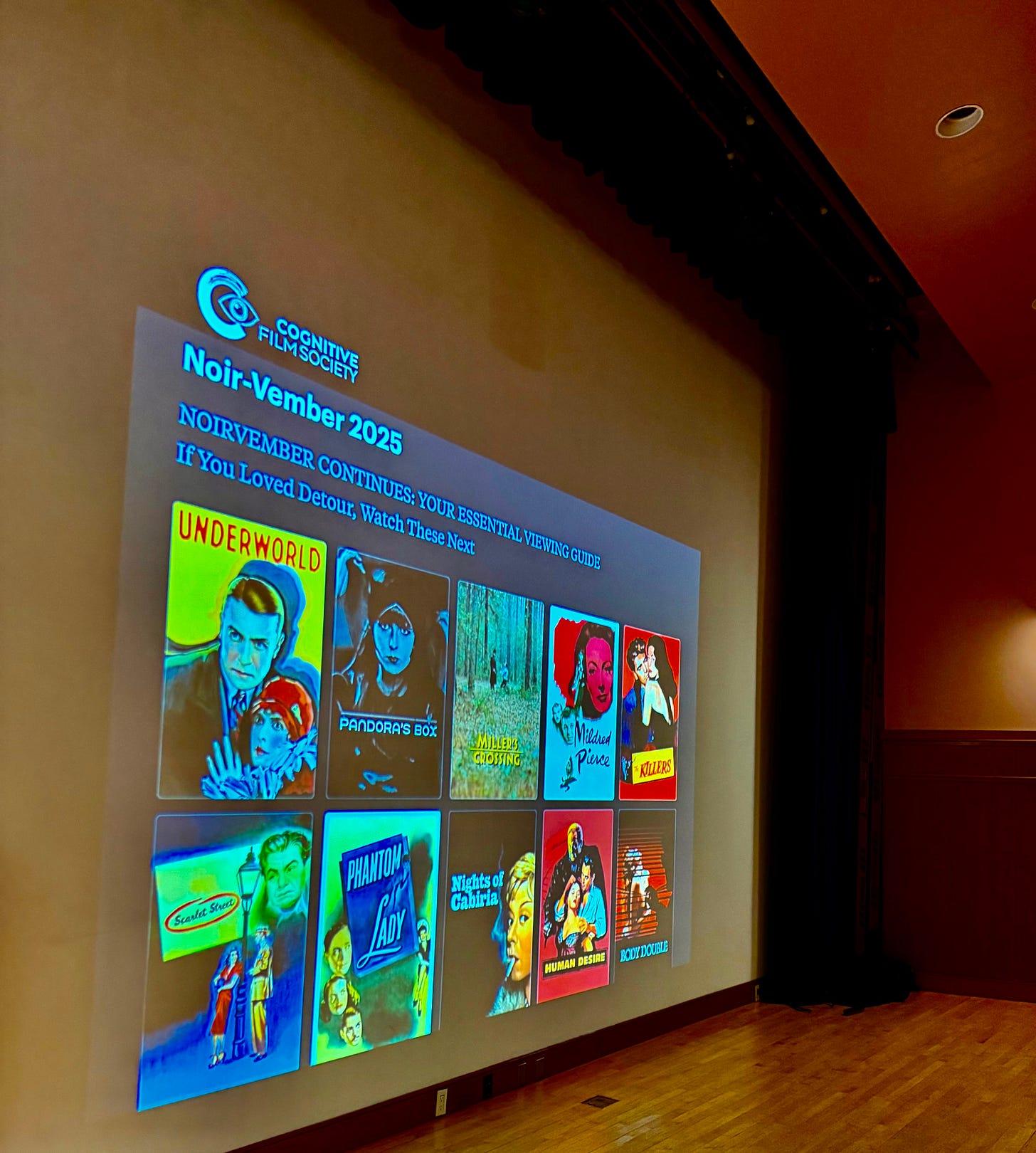Last Sunday afternoon, the Gold Theater at Hewlett-Woodmere Public Library filled with our largest crowd yet—neighbors discovering film noir for the first time, longtime devotees returning to a masterpiece, and everyone in between gathering to launch NoirVember with Edgar G. Ulmer’s Detour (1945).
What made this screening special wasn’t just the film. It was what came before: live jazz from two extraordinary Hewlett High School seniors, context from filmmaker Alex Rollins Berg, and the kind of intergenerational conversation that proves cinema still works best when experienced together.
Jazz Sets the Mood
Aleksy Fradlis and Victoria Brodsky brought sophistication and maturity far beyond their years to a set of standards from the late 1940s and 50s—the exact era when Detour emerged from Poverty Row. They performed “My Funny Valentine,” “Embraceable You,” and “Time After Time,” transporting the audience directly into the smoky dive bars where Detour‘s protagonist Al Roberts once played piano.
Jazz and noir share DNA: improvisation within constraint, beauty emerging from limitation, desperate hope meeting inevitable doom. Their performance created the perfect atmosphere for Ulmer’s 68-minute nightmare—proof that presentation elevates experience, that taking time to set a mood pays dividends.
While both students will be graduating this year, their performance reminded us why the Cognitive Film Society exists: to create moments where art forms dialogue with each other, where high school musicians and 1945 cinema meet, where community gathers around shared cultural experience.
Alex Rollins Berg on Ulmer’s Journey
Before the film, we screened an introduction from filmmaker and NYU professor Alex Rollins Berg, who runs the essential newsletter Underexposed. Alex traced Edgar G. Ulmer’s remarkable journey from building sets for Metropolis in Weimar Germany to directing masterpieces on Hollywood’s Poverty Row.
Ulmer studied with Max Reinhardt, worked with Fritz Lang and F.W. Murnau, understood German Expressionism from the inside. When scandal exiled him from major studios, he brought that European sophistication to America’s cheapest production houses. Detour cost almost nothing—but it’s the only Poverty Row film in the National Film Registry.
That’s because constraints forced innovation. Ulmer understood noir isn’t about expensive sets but about psychology, paranoia, and making audiences question everything they see. Directors from Jean-Luc Godard to Wim Wenders have cited Detour as influential. Wenders called Ann Savage’s performance as Vera “30 years ahead of its time.”
The Film & The Discussion
Who is the protagonist of Detour? Is it Al Roberts, the man telling the story? Or Haskell, whose identity he assumes?
Did Roberts actually kill anyone, or is he lying to himself—and to us?
These questions sparked immediate debate. The film makes everything ambiguous. Reality becomes suspect.
And then there’s Vera. Ann Savage materializes in a stolen car like Roberts’s conscience made flesh—pure hostility wrapped in a cheap coat. Her performance remains shocking 80 years later.
The Q&A revealed what we love most: diverse perspectives colliding. Teenagers seeing noir for the first time debated fate versus free will with longtime film devotees. Some argued Roberts was trapped by circumstance; others insisted he made catastrophic choices.
Everyone agreed Vera was intense, though opinions split on whether she’s villain or survivor.
This was our first screening with student volunteers helping run the program. From greeting audience members to distributing programs to technical setup, these young people demonstrated that building cultural infrastructure requires hands across generations.
Your NoirVember Viewing Guide
Want to continue your noir journey? We’ve curated sixteen essential films—from 1927’s Underworld (the source code) to 1984’s Body Double—on our Letterboxd list.
Many of these are available free at your local library. The Hewlett-Woodmere Public Library has an excellent noir collection, and we encourage you to check them out.
Join Us for GILDA: Our First Annual Gala
December 10th, 6:30 PM
Regal Cinemas Lynbrook
We’re capping 2025 with our First Annual Gala—a celebration of Old Hollywood glamour on the big screen where it belongs.
Rita Hayworth at the peak of her powers in Charles Vidor’s 1946 masterpiece. Pure elegance: stunning gowns, dramatic lighting, and a love triangle dripping with betrayal in post-war Buenos Aires. This is classic Hollywood at its most seductive—George Macready and Glenn Ford caught in Hayworth’s orbit, unable to escape.
Why see Gilda on the big screen?
Because Hayworth’s iconic performance—that black satin gown, “Put the Blame on Mame,” the moment she enters frame and changes everything—demands theatrical presentation. This film made her a legend. Seeing it in a theater, the way 1946 audiences experienced it, is the only way to understand why.
This will be a ticketed event with limited seating. Tickets and full details will be available soon!
Thank You
To the Hewlett-Woodmere Public Library for hosting us in the Gold Theater.
To Aleksy Fradlis and Victoria Brodsky for a beautiful performance.
To Alex Rollins Berg for essential context.
To our student volunteers for building this community.
To everyone who filled the theater Sunday—our largest crowd yet—proving that people hunger for cinema that challenges and refuses easy answers.
See you December 10th for Gilda.














